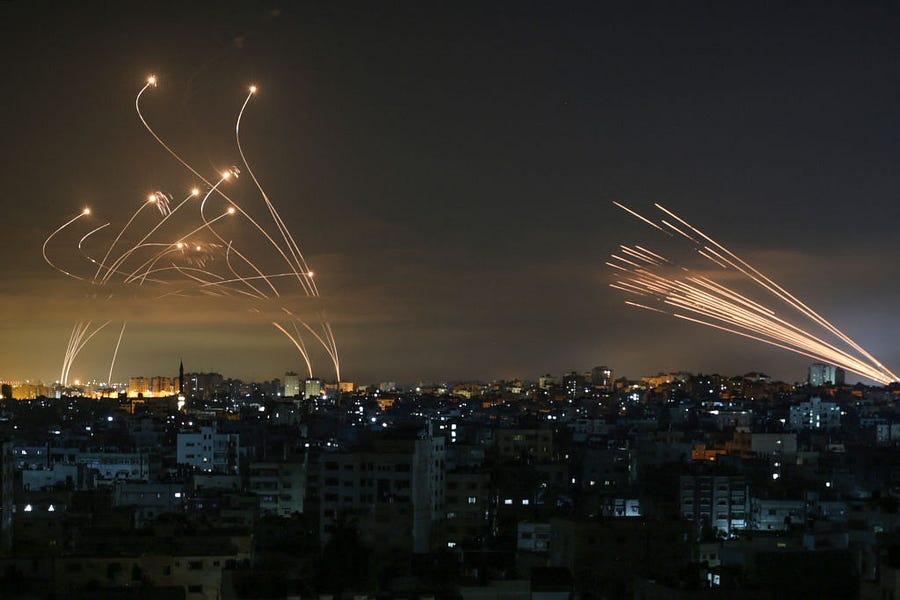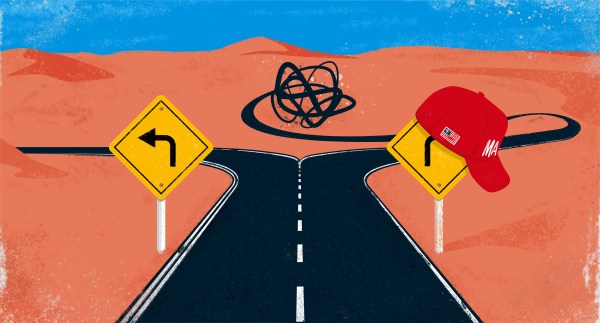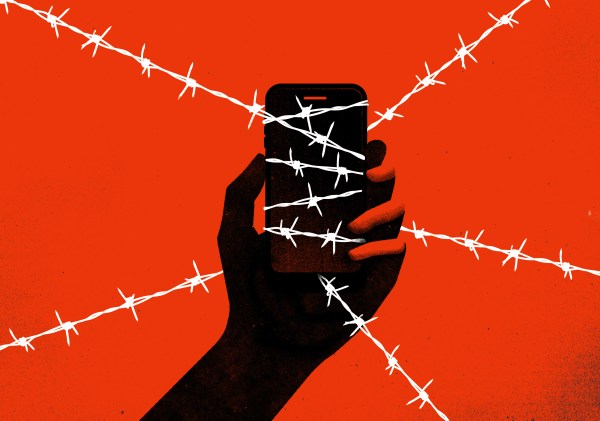As cross-border rocket fire between Israel and Gaza intensifies, families across Israel are becoming full-time occupants of their home, apartment, and neighborhood bomb shelters.
“The past several days have been especially challenging as a parent, in having to answer difficult questions posed by our 6-year-old daughter,” Adam Levick, who lives with his wife and two young children in Modi’in, told The Dispatch after Tuesday night’s attacks. “Though they’ve prepared her at school to some degree, we had to carefully explain to her, in language she would understand, but not language that would scare her, that there are people who want to hurt us, but that we’ll be safe in the shelter, and that our army—a word she likely doesn’t fully understand—and God—a word she does understand, as we are religiously observant—are protecting us.”
Modi’in, along with other cities across central Israel, has come under unprecedented rocket fire in the past several days, as Hamas unleashes its artillery on heavily populated civilian areas in retaliation for recent Arab-Jewish skirmishes in the Israeli capital of Jerusalem.
Before foreboding U.N. warnings of “full-scale war,” Amos Giland—a former Israeli defense official—described the lead-up to the conflict as a “powder keg” primed to “explode at any time” early this week. On Monday morning, a clash between police and Palestinians left more than 500 participants—mostly Muslim—wounded in the capital’s holiest site. By Monday evening, Hamas militants based in the Gaza Strip had retaliated with more than 450 rockets aimed at cities across Israel.
The Israeli Defense Forces (IDF) hit back in a series of targeted strikes the same night, setting off an aerial fight with alarming casualties on both sides. Early morning Friday, Israeli ground forces—including troops, artillery, and tanks—had amassed at the border with Gaza. But despite misleading statements from Israel’s military and premature reports from the media, no ground offensive has been launched into the territory yet.
According to the Gaza-based Palestinian Ministry of Health (a source that analysts have rightly cautioned should be taken with a grain of salt), at least 109 Gazans have been killed since Monday, including 28 children. Nine Israelis, including a 6-year-old boy, have also been killed.
“As the battleground shifts from Jerusalem to Gaza, things are likely to only escalate further,” Carmiel Arbit, a senior fellow for Middle East programs at the Atlantic Council, told The Dispatch Monday. “Israel will strike Gaza until the government feels it has restored deterrence and Hamas will retaliate to demonstrate its strength,” Several days later, with no ceasefire in sight, Arbit’s prediction rings true.
Depending on who you ask, this recent uptick in violence is rooted in several different points of local tension. Many point to the Israeli government’s impending eviction of six Palestinian families from residences in East Jerusalem’s Sheikh Jarrah neighborhood, an ongoing legal battle with dubious claims on both sides, as the source of this most recent conflict. Protests and rioting among the city’s Palestinian population broke out around the start of Ramadan last month, and persist even as Israel’s Supreme Court moved to postpone the verdict Sunday.
On Monday, crowds of Israelis gathered for an annual celebration marking the reunification of Jerusalem following the 1967 Six-Day War, when Israel preempted an invasion from its Arab neighbors and multiplied its territory over the course of less than a week. The parade typically passes through Damascus Gate, a flash point of recent fighting, but changed its route this time to avoid direct confrontation. Several media outlets have described the holiday as a “provocation.”
But other analysts say Jerusalem is a lightning rod, emotionally charged enough to spark conflict but ultimately a pretense for Hamas to assert its dominance amid deteriorating domestic power. Late last month, Palestinian Authority President Mahmoud Abbas canceled the first parliamentary elections to be held since 2006 as Hamas and splinter factions of Fatah threatened to strip his party of its majority.
“Hamas was slated to take part in those elections and was likely going to win a fair number of seats, if not a majority. In the end Abbas was persuaded to cancel those elections, leaving Hamas with little recourse in terms of its ability to garner additional political support,” Jonathan Schanzer, senior vice president of the Foundation for Defense of Democracies and author of Hamas vs Fatah: The Struggle for Palestine, told The Dispatch. “In many ways this current round of conflict strikes me as an attempt by Hamas to regain primacy in the Palestinian political arena.”
“They’re trying to make a major bid to become the dominant force within the Palestinian national movement. Without a doubt,” added Aaron David Miller, a senior fellow at the Carnegie Endowment for International Peace. “Abbas is in the 16th year of his four-year term. He’s lost credibility as a consequence of cancelling elections.”
Amid the Palestinian Authority’s crumbling legitimacy and other crises facing the West Bank and Gaza—food and water shortages, the rapid spread of COVID-19, and rampant poverty—Hamas finds a foothold by inflicting maximum pain on Israeli civilians.
With an artillery of between 20,000 and 30,000 projectiles, the group takes aim at urban centers, critical infrastructure, and military targets across Israel. Iron Dome—one of the world’s most advanced missile defense systems—is reported to have taken down about 90 percent of the more than 1,700 rockets that breached Israeli airspace this week.
But Hamas’ efforts to overwhelm interceptors by sheer quantity and frequency allowed some strikes to slip through the cracks, as evidenced by successful hits on the Ashkelon pipeline, Port of Ashdod, and several civilian targets. Many others fell short of the border with Israel, landing in Gaza and killing at least eight civilians—including two children—per a Palestinian rights group.
What some international critics, including foreign governments, have deemed Israel’s “disproportionate use of force” is perhaps more accurately described as a “disproportionate defensive capability,” or even “alternative defensive prerogatives.” Far more missiles, rockets, UAVS, and mortar shells have been deployed from Gaza to Israeli towns and cities than vice versa, but Iron Dome—which remains fully operational despite efforts by Hamas to bombard its batteries—is highly effective at neutralizing threats to civilians.
Hamas employs the inverse strategy. With a long and well-documented history of embedding military personnel and weaponry in residential areas—including schools and hospitals—the organization furthers two objectives: 1) deterring Israeli strikes on infrastructure and 2) cultivating international sympathy when the former fails.
This tactic explains, from a geopolitical perspective, why the IDF often issues warnings before bombing civilian-occupied buildings: Purposefully striking Gazan civilians doesn’t alter Hamas’ military calculus, nor does it earn Israel any goodwill from the international community. These considerations do not, of course, absolve Israel of responsibility for Palestinian deaths and injuries as collateral damage, but they provide necessary context to disparate casualty rates.
Over the course of four days, Israeli forces have struck Hamas rocket and weapons manufacturing and storage sites, two “terror tunnels,” a military post of its naval base, and at least 15 mid- to top-tier military personnel. Among the operatives killed are Fathi Faik Sharir, commander of the Hamas anti-tank missile unit; Sameh Fahim Al-Mamlouk, a senior commander in the Al-Quds Brigades; Hassan Kaogi, head of the Hamas military security department; and Bassem Issa, the commander of Hamas’s Gaza City Brigade.
Speaking to Army Radio Tuesday, an IDF spokesman said the military has “not ruled out” a ground operation if violence persists. Thursday, Israeli Defense Minister Benny Gantz approved the call-up of 9,000 reserve soldiers. Such a move would be costly to both sides, onlookers warn, pointing to the 2014 Gaza War that left at least 2,200 Palestinians and 73 Israelis dead.
Some analysts are confident that the cross-border fighting won’t escalate to a full-scale intervention. “Netanyahu—despite his reputation—is actually a very cautious political leader when it comes to military activity. Putting troops on the ground is a major step and one that will imperil Israeli lives,” Schanzer explained. “I think the Israelis would much prefer a battle from the air.”
But unrest brewing within Israel proper may pose an even greater strategic threat than outside forces. Across the nation, clashes between religious factions in Jewish-Arab cities and towns have grown more destructive by the day. In Lod, a mixed city that once touted its coexistence, Arab mobs attacked Jewish-owned residences, a school, synagogue, and city hall in what one Jewish resident described as “like Kristallnacht.” The same night, an Arab Israeli man was shot and killed—and two others were wounded—by a Jewish suspect claiming self defense.
“I call on and beg of all local leaders, religious leaders, on citizens, on parents. Do all you can to stop this terrible thing that is happening before our eyes,” President Reuven Rivlin implored Wednesday. “We are dealing with a civil war between us without any reason. Please stop this madness.”
“You’ve got Jews shooting Arabs, and Arabs throwing Molotov cocktails at Jewish residences. That’s almost unprecedented,” Miller told The Dispatch, adding that in 2000 Israeli police shot dead 12 Israeli Arabs and one Palestinian. “That was considered a travesty—a government killing its own citizens.”
Reverberations of this week’s conflict have been felt in the United States, where strong opinions and minimal nuance dominate the discourse. Within the ranks of the Democratic Party, diverging approaches are leading to political infighting. New York City mayoral contender Andrew Yang’s tweet Monday in solidarity with Israeli civilians, for example, now poses a threat to his candidacy.
Rep. Alexandria Ocasio-Cortez bashed his attendance at an Eid event after issuing the “chest-thumping statement” as “utterly shameful.” #YangSupportsGenocide trended on Twitter.
The Biden administration has also faced backlash for its handling of the crisis, which thus far has followed the American company line of support for Israel’s right to self defense. “There is a very clear and absolute distinction between the terrorist organization Hamas that is indiscriminately raining down rockets targeting civilians, and Israel’s response defending itself, targeting the terrorists raining down rockets on Israel,” Secretary of State Antony Blinken said during a press briefing.
According to a White House readout of a call between Biden and Netanyahu Wednesday, the president conveyed “his unwavering support for Israel’s security and for Israel’s legitimate right to defend itself and its people, while protecting civilians.”
But to Schanzer, the niceties between the U.S. and Israel overlook “the elephant in the room”: Iran’s invariable role in the violence. “There has been a shadow war between Israel and Iran for the last several months. And it has been more intense than previously understood. Israel has struck Iranian assets in Syria, in cyberspace, on the high seas—and it has done so with relative impunity,” he explained. “It is my strong sense the Hamas attacks right now against Israel are being done with guidance and assistance from Iran.”
A Palestinian Islamic Jihad Official Ramez Al-Halabi confirmed as much Wednesday, speaking to an Iraqi television statement. “Today, the patronage of the axis of resistance has begun to prevail in the region, thanks to Allah and to the blood of the martyrs… first and foremost, the axis between Jerusalem and Tehran,” Al-Halabi said, according to a translation by MEMRI TV.
“I am proud to say that the rockets that are used to pound Tel Aviv have an Iranian signature on them, the signature of Qassem Suleimani.”
Israel now has an eye on its northern borders, anticipating the possible intervention of other Iranian proxies based in Lebanon and Syria. Iranian Foreign Minister Mohammad Javad Zarif paid a visit to Damascus to discuss “Israeli regime’s brutal aggression against Palestinians” with Syrian President Bashar al-Assad and other officials Wednesday. And unconfirmed reports by Lebanese media indicated that three rockets, from Hezbollah or a Hamas presence, were launched from Lebanon and into Israel Thursday.
“As the Biden administration looks to try to restore calm, and to engage with the Israelis, it will be doing so from a position of weakness and the perception that it is about to exacerbate the conflict—through financial means, if not through overall diplomacy and perhaps the unwillingness to hold Iran accountable,” Schanzer said.







Please note that we at The Dispatch hold ourselves, our work, and our commenters to a higher standard than other places on the internet. We welcome comments that foster genuine debate or discussion—including comments critical of us or our work—but responses that include ad hominem attacks on fellow Dispatch members or are intended to stoke fear and anger may be moderated.
With your membership, you only have the ability to comment on The Morning Dispatch articles. Consider upgrading to join the conversation everywhere.